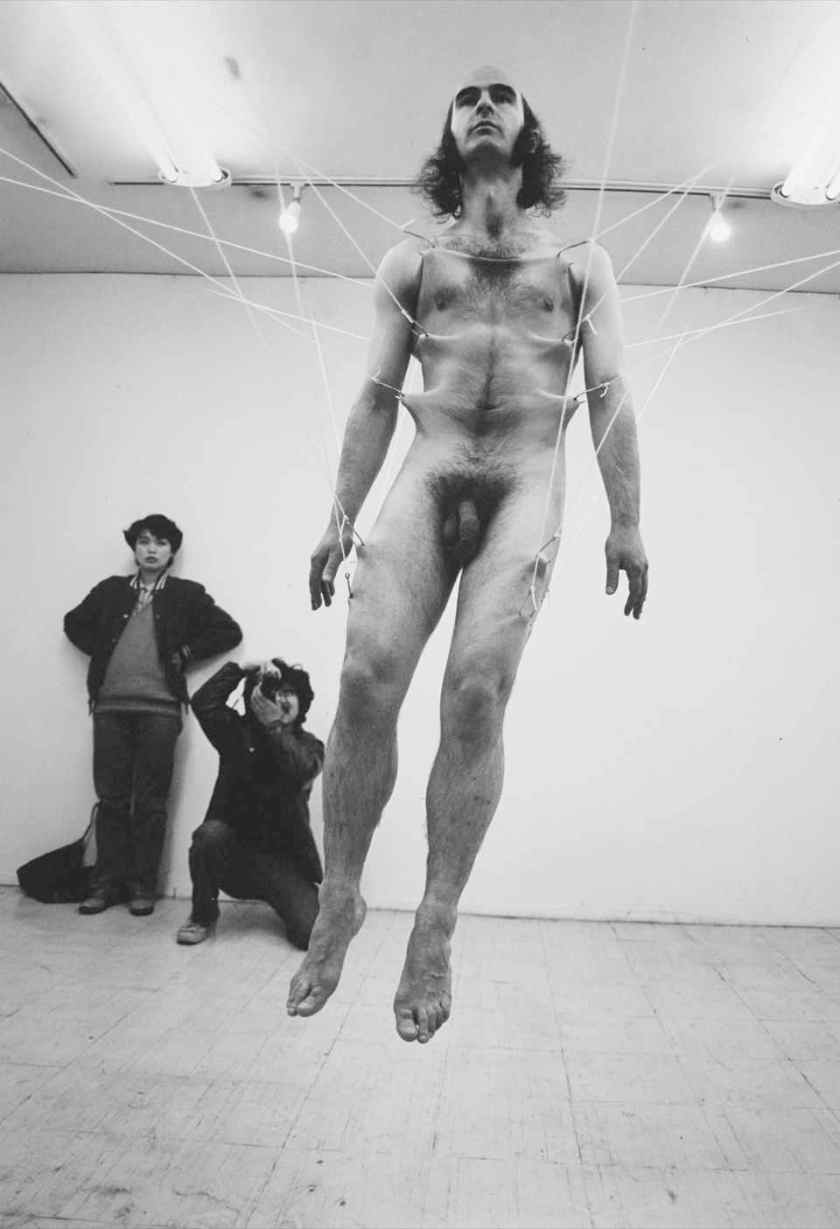The body as a canvas has increasingly become a canvas for technology, acting as an experiment of shifting techo-centric identities. Technology has been utilised as an art form – with the ability to alter and shape the way we interact with the world not only within a physical space, but a virtual one as well, we are able to break beyond the boundaries of what our established notion of human identity is. Technology has thus become post-modernism’s manifesto – and with it, our bodies have become objects we are unafraid to alter.
 (such as Stelarc’s performace artwork, as discussed in my previous post)
(such as Stelarc’s performace artwork, as discussed in my previous post)
As technology develops, we are able to use our bodies as the interaction for the machine – we become the interface. This is seen in RedTacton, where the ability to “[send] data over the surface of the skin, it may soon be possible … to swap phone numbers by kissing” (Taipei Times 2005), and ‘Brain Orchestra’, which aims to “see what the brain can do without the body” (BBC News 2009).
We then reject the idea of the corporeal form, moving beyond the limitations of our physical bodies.“The human modification of the natural world” (Tenner 2004) is, thus, authorisation of body as canvas. Ultimately we aim to better the form of the body through augmentation, which has both assistive and destructive implications.
Humanity is constantly obsessed with enhancing our form – we are not happy with the flimsiness of our body, the temporal nature of our lives. We see technology as an aid for correcting nature’s mistakes. However, this combination of a human-technology identity does have negative consequences; Society will ultimately be altered in drastic ways, specifically, issues with “…security, wealth, language (and body language) and our understanding of what it is to be organic will shift” (Forder 1998).
“Are we to paint what’s on the face, what’s inside the face, or what’s behind it?”
– Picasso
In relation to post-humanism, Picasso has also shifted and altered the human form and thrown it in the face of society through his art. His work ultimately reflects our attitude towards the altering of the human form in our current post-modern era.
 Les Demoiselles d’Avignon – Pablo Picasso (1907)
Les Demoiselles d’Avignon – Pablo Picasso (1907)
Consequences: Desire of Knowledge
Are we to paint what’s on the face? The way in which we choose to present ourselves, our identities, through physical manifestations, shows an important aspect of how technology has already begun to seep into our idea of the self – how we communicate, the images we choose to show on Facebook. As this begins to develop in the future, we may find ourselves with a rich virtual identity but a shallow physical presence. As technology “may soon be able to communicate our subconscious states” (Gosman 2009), the issue of personal space and privacy poses as a huge threat on mental health and security.
Consequences: Desire of Physical Manipulation
Are we to paint what’s inside the face? In terms of health science, genetic engineering allows for the prolonging of life through high “standards of health” (Ihde 1993) and the introduction of medicines, such as the “Salk vaccine for polio” (Ihde 1993). As beneficial as genetic engineering is currently, in terms of projected post-humanist scenarios, this raises questions of over-population, food supply and over-reliance of technology to achieve a normal standard of living.
The ‘end of the human’ (Graham 2002), can thus be seen as the ultimate dependence and desire to become as involved the complex nature a techno-centric identity (Ihde 1993). Are we to paint what’s behind it? The question of painting behind the ‘face’ is ambiguous. Are we one to correct the fallible human body, ultimately reshaping what we deem as normal society today? Where does the organic human identity lie, and where does the technological augmentation begin? These are huge questions with many possible answers, all of which cannot be solved today – only time will tell if we adapt or reject these notions of a new form of human identity.
REFERENCE LIST
- Arnold, P. 2009, ‘Pros and Cons of Genetic Engineering in Humans, Bright Hub, 2 November, <http://www.brighthub.com/science/genetics/articles/22210.aspx>
- Goman, C.K. 2009, ‘The High-Tech Future of Body Language’, Washington Post, 22 October, <http://views.washingtonpost.com/leadership/leadership_playlist/2009/10/the-high-tech-future-of-body-language.html>
- Palmer, J. 2009, ‘World Premier of Brain Orchestra’, BBC News, 24 April, <http://news.bbc.co.uk/2/hi/science/nature/8016869.stm>
- Rubens, P. 2005, ‘New technology uses human body for broadband networking’, Taipei Times, 20 March, <http://www.taipeitimes.com/News/biz/archives/2005/03/20/2003247076>
- Unknown. 2005, ‘New technology to use human body as digital transmission path’, Physorg, 22 February, <http://www.physorg.com/news3153.html>
- Forder, J. 1998, ‘The Body as Password – biometric technology and the form of appropriate legislation”, Law Papers Bond University, <http://epublications.bond.edu.au/law_pubs/27>>
- Baker, V. 2011, ‘Painting the truth’, Greenwich Post, 16 February, <http://www.acorn-online.com/joomla15/greenwich-post/columns/loveandopera/85938-painting-the-truth-.html>
- Picasso, P. 1907, Les Demoiselles d’Avignon, Museum of Modern Art, New York.
- Ihde, D (1993) “Technology” (p.47-64) in Philosophy of Technology, Paragon House, New York
- Unknown. (2002). Genetic Engineering in Humans. Available:http://www.allaboutpopularissues.org/genetic-engineering-in-humans-faq.htm.